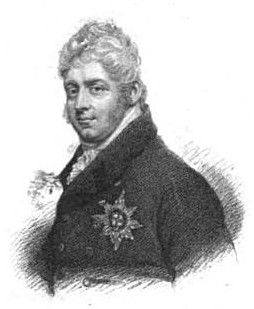 |
Frances, Countess of Jersey,
by Thomas Watson after Daniel Gardner,
mezzotint pub 1774 © National Portrait Gallery, London |
Profile
Frances Villiers, Countess of Jersey (25 February 1753 - 25 July 1821), was an influential member of Georgian society and a mistress of George IV.
An Irish beauty
Frances Twysden was born on 25 February 1753 in Raphoe, Donegal, in Ireland, the posthumous daughter of Philip Twysden, the bankrupt Bishop of Raphoe, and his second wife, Frances.
Marriage to “the Prince of Maccaronies”
On 26 March 1770, Frances married George Bussy Villiers, the 4th Earl of Jersey, at the home of her step-father, General James Johnston, an aide-de-camp to
George III. The Earl was almost twenty years her senior and was Gentleman of the Bedchamber to George III. He was known for his courtly manners, leading to the bluestocking
Mrs Montagu dubbing him “the Prince of Maccaronies.”
1
Family life
George and Frances had ten children, two sons and eight daughters: Charlotte (1771), Anna (1772), George (1773), Caroline (1774), Georgiana who died as an infant (1776), Sarah (1779), William (1780), Elizabeth (1782), Frances (1786) and Harriet. (1788)2
As Frances was by no means faithful, it is probable that some of her children were fathered by other men. However, she appears to have been genuinely attached to her husband who stood by her throughout their marriage.
What was she like?
A great beauty, known for her charm, intelligence and wit, Frances was also a malicious gossip, notorious for her spiteful and vengeful nature. She was described in the Journal of Mary Frampton as
a clever, unprincipled, but beautiful and fascinating woman, though with scarcely any retrieving really good quality.3
Lady Bessborough was equally condemnatory, once remarking that Lady Jersey could not be happy “without a rival to trouble and torment.”
4
 |
Georgiana Cavendish in the "picture hat"
after Thomas Gainsborough c1785-7
from The Two Duchesses, Family Correspondence (1898) |
Richard Brinsley Sheridan modelled his character Lady Sneerwell on a combination of her and
Lady Melbourne in his play School for Scandal in 1777.
Whig campaigner
Frances became friends with Georgiana, Duchess of Devonshire, and was part of the Devonshire House set that formed the hub of the Whig party. In the election of 1784, she campaigned alongside Georgiana and her sister Harriet in support of Charles James Fox, dressed in the Whig uniform of blue and buff with a foxtail in her hat.
Lovers
Frances was not faithful to her husband and engaged in a succession of affairs. Her lovers included Frederick Howard, 5th Earl of Carlisle; Lord Morpeth; William Augustus Fawkener, clerk to the Privy Council; and William Cavendish, 5th Duke of Devonshire, husband of her ‘friend’ Georgiana, with whom she had a brief affair in 1778, which was terminated through the intervention of Georgiana’s family, the Spencers.
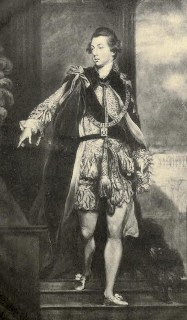 |
Frederick Howard, 5th Earl of Carlisle
from the History of White's
by A Bourke (1892) |
Mistress to the Prince of Wales
But by far the most famous of Lady Jersey’s lovers was
George, Prince of Wales. From as early as 1782, George was attracted to Frances, who was nine years older than him, but it was not until 1793 that she became his mistress, by which time she was forty years old and a grandmother.
Having become George’s mistress, Frances was keen to establish her position. She encouraged the Prince to abandon
Mrs Fitzherbert permanently and get married to solve his financial problems. She supported the choice of his cousin Caroline, believing that she would be no competition for her own attractions.
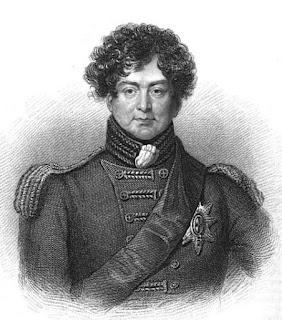 |
George IV
from La Belle Assemblée (1830) |
The misery of the Princess of Wales
In 1795, the besotted Prince appointed Lord Jersey as his Master of the Horse and made Frances Lady of the Bedchamber to his new bride. Frances lost no opportunity to taunt the
Princess of Wales. She arrived late to meet her when she first arrived in England and then criticised her dress. She appeared openly as the Prince’s consort and drove about in a carriage accompanied by servants wearing the Prince’s livery.
Princess Caroline hated Frances’ influence and begged to have her removed from her position by writing repeatedly to the Prince. Frances was also accused of stealing Caroline’s letters and passing them to the
Queen.
![The Jersey smuggler detected; - or - good causes for discontent [separation] Print made by James Gillray 24 May 1796 Published by Hannah Humphrey © British Museum The Jersey smuggler detected; - or - good causes for discontent [separation] Print made by James Gillray 24 May 1796 Published by Hannah Humphrey © British Museum](https://blogger.googleusercontent.com/img/b/R29vZ2xl/AVvXsEhOlyPZ6kPxYNU-djSs2NNQCDXnWY3m4qQ5ah3H0xRrbcB4xfAosXKe5t0d0jICTzezpAAU5nZy_-IMvvpz13tERC5wSs1YQS4QSBQtmxTncgAdSqa2zgMCKZyUnH23klp7D7KoE5bj-n8T/s400/Satirical+print+by+Gillray+-+British+Museum+-+1796.jpg) |
The Jersey smuggler detected; - or - good causes for discontent [separation]
Print made by James Gillray 24 May 1796
Published by Hannah Humphrey © British Museum |
Growing unpopularity
Public opinion sided with the seemingly ill-treated Princess of Wales, and Lady Jersey and the Prince became increasingly unpopular. A mob stoned Frances’ London house and, when she visited Brighton, she was humiliated by a skimmington - two people masquerading as herself and the Prince, parading through the town on a donkey. Even amongst the ton she was shunned, most notably at a ball held by the
Duchess of Gordon.
Lady Spencer declared that
Lady J. is in everything, and by everybody most thoroughly disapproved.6
Eventually, on 29 June 1796, Frances offered to resign from her post, claiming that she would have resigned earlier except that such an action seemed to prove her guilt.
 |
Caroline, Princess of Wales
from La Belle Assemblée (1806) |
But it was not the end of the Prince’s affair with Frances. The Jerseys moved into a house in Warwick Street, adjacent to Carlton House, creating fresh scandal, and Lady Jersey spent Christmas with the Prince at Critchell House near Wimborne Minster.
The end of the affair
By 1798, the fickle Prince had tired of Lady Jersey. He sent his friends to negotiate an amicable parting, but Frances was reluctant to be put aside. But by June 1799, the affair was over. The Jerseys moved out of the house in Warwick Street and the Earl was dismissed from his role as Master of the Horse. All intimacy was at an end.
"That infernal Jezabel"
Frances was furious and blamed Georgiana, who had been reconciled with the Prince, for turning him against her. She determined to plague the Prince, and by all accounts succeeded, as in 1814, he railed against “all the wickedness, perseverance and trick of that infernal Jezabel Lady Jersey.”7
According to Aspinall, Lady Jersey
tried to pay off old scores by making mischief in the Orange marriage, but it does not seem that her influence on Princess Charlotte was considerable.8.
Money problems
After her separation from the Prince, Frances was beset with financial difficulties, and in 1802, Lord Jersey was threatened with imprisonment over his debts.
On 22 August 1805, the Earl died and Frances was left without sufficient means to support her in the life to which she was accustomed. She applied to the Prince for a pension which was eventually, reluctantly, granted (9). Her son George, the 5th Earl of Jersey, increased her jointure and paid her debts from time to time, but she had no notion of economy.
Death
Frances died on 25 July 1821 in Cheltenham and was buried in the family vault at Middleton Stoney. After her death, her executor, Lord Clarendon, burned many of her papers, including correspondence relating to George IV.
The other Lady Jersey
 |
Sarah Sophia, Countess of Jersey
from The Illustrated Belle Assemblée (1844) |
Frances is not to be confused with her daughter-in-law,
Sarah, who was married to her elder son George Child Villiers, 5th Earl of Jersey, and was a leading member of the ton and a patroness of
Almack’s.
Rachel Knowles writes clean/Christian Regency era romance and historical non-fiction. She has been sharing her research on this blog since 2011. Rachel lives in the beautiful Georgian seaside town of Weymouth, Dorset, on the south coast of England, with her husband, Andrew.
Find out more about Rachel's books and sign up for her newsletter here.
If you have enjoyed this blog and want to encourage me and help me to keep making my research freely available, please buy me a virtual cup of coffee by clicking the button below.
Notes
(1) From
George Bussy Villiers , fourth Earl of Jersey (1735-1805) Oxford Dictionary of National Biography by HE Maxwell (2004).
(2) From
Debrett's Complete Peerage (1838).
(3) From
The Journal of Mary Frampton (1885).
(4) From
George IV by Christopher Hibbert (1972, 1973).
(5) From
Georgiana, Duchess of Devonshire by Amanda Foreman (1998).
(6) From
Georgiana, Duchess of Devonshire by Amanda Foreman (1998).
(7) From
The Letters of King George IV edited by A Aspinall (1838).
(8) From
The Letters of King George IV edited by A Aspinall (1838).
(9) From
George IV by Christopher Hibbert (1972, 1973).
Sources used include:
Bourke, Hon Algernon, The History of White's (1892)
Courthope, William, editor,
Debrett's Complete Peerage of the United Kingdom of Great Britain and Ireland (1838)
Foreman, Amanda,
Georgiana, Duchess of Devonshire (HarperCollins, 1998, London)
Frampton, Mary,
The Journal of Mary Frampton (1779-1846) edited by Harriot Georgiana Mundy (1885)
George IV,
The Letters of King George IV 1812-1830 edited by A Aspinall in 3 volumes (1838)
Hibbert, Christopher,
George IV (1972, Longmans, 1973, Allen Lane, London)
Levy, Martin J,
Villiers, Frances, Countess of Jersey (1753-1821) Oxford Dictionary of National Biography (Oxford University Press, 2004; online edn Jan 2008, accessed 8 Apr 2013)
Maxwell, HE,
Villiers, George Bussy, fourth Earl of Jersey (1735-1805) Oxford Dictionary of National Biography, rev MJ Mercer (Oxford University Press, 2004; online edn Jan 2008, accessed 10 Apr 2013)
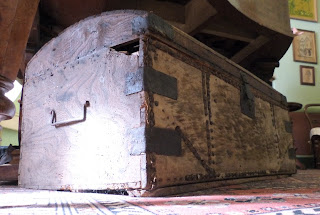

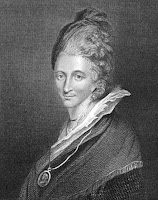
































,+Lord+Byron's+Correspondence+(1922)+-+cropped.jpg)










![The Jersey smuggler detected; - or - good causes for discontent [separation] Print made by James Gillray 24 May 1796 Published by Hannah Humphrey © British Museum The Jersey smuggler detected; - or - good causes for discontent [separation] Print made by James Gillray 24 May 1796 Published by Hannah Humphrey © British Museum](https://blogger.googleusercontent.com/img/b/R29vZ2xl/AVvXsEhOlyPZ6kPxYNU-djSs2NNQCDXnWY3m4qQ5ah3H0xRrbcB4xfAosXKe5t0d0jICTzezpAAU5nZy_-IMvvpz13tERC5wSs1YQS4QSBQtmxTncgAdSqa2zgMCKZyUnH23klp7D7KoE5bj-n8T/s400/Satirical+print+by+Gillray+-+British+Museum+-+1796.jpg)


